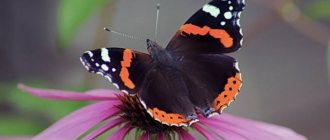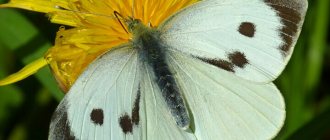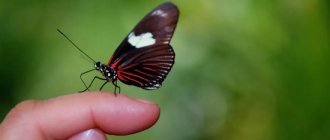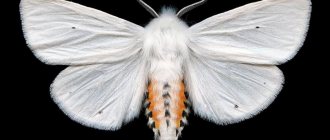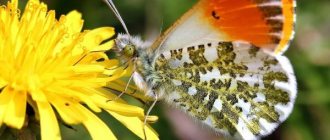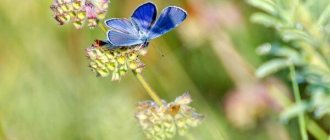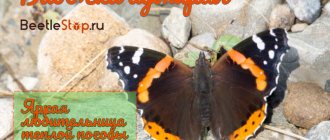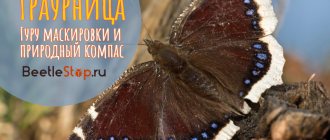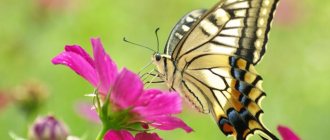The common Apollo butterfly from the swallowtail family lives in dry pine forests, wastelands and rocky mountain slopes. It is easily recognized by the light color of its wings and a pattern of black and red spots. Adults are large, wingspan up to 90 mm. Butterflies are active during the day and fly all summer, feeding on nectar-bearing asteraceous plants. The caterpillar feeds on various types of sedums. Local residence of Apollo colonies led to a reduction in the number of individuals. The destruction of natural habitats brings the species closer to extinction. The sailboat Apollo is listed in the European Red Book and environmental documents of individual countries.
Morphological description of the species
The Apollo butterfly (Parnassiusapollo) belongs to the genus Parnassius of the swallowtail family. The specific name comes from the name of Apollo, a beautiful god from Greek myths, son of Zeus and brother of Artemis. The diurnal butterfly with a wingspan of 60-90 mm is the largest species of its genus. The main color of the wings is white, with small transparent areas along the outer edge.
There are 5 rounded black spots on the fore wings of the male, and red ocellated spots with a white center on the hind wings. The female is brighter colored. Young adults that have left the pupal cocoon have wings with a yellowish tint. The body of butterflies is covered with thick hairs. The eyes are large, bulging, and the antennae are club-shaped. The pattern on the wings of the Apollo swallowtail butterfly has about 600 options. Even within the same region, the distribution of spots differs among different colonies.
Information. Despite the fact that Apollos belong to the sailfish family, they lack tails on their hind wings.
Notes
- Striganova B. R., Zakharov A. A.
Five-language dictionary of animal names: Insects (Latin-Russian-English-German-French) / Ed. Doctor of Biology sciences, prof. B. R. Striganova. - M.: RUSSO, 2000. - P. 265. - 1060 copies. — ISBN 5-88721-162-8. - Korshunov Yu. P.
Keys to the flora and fauna of Russia // Mace Lepidoptera of Northern Asia. Issue 4. - M.: Partnership of Scientific Publications KMK, 2002. - P. 33. - ISBN 5-87317-115-7. - ↑ Tikhonov A.
Red Book of Russia. Animals and plants. - M.: ROSMEN, 2002. - 414 p. — 10,000 copies. — ISBN 5-353-00500-7. - ↑ Day butterflies (Hesperioidea and Papilionoidea, Lepidoptera) of Eastern Europe. CD identifier, database and Lysandra software package. I. G. Plyushch, D. V. Morgun, K. E. Dovgailo, N. I. Rubin, I. A. Solodovnikov. Minsk, 2005
- K. Lampert.
Atlas of butterflies and caterpillars. - Minsk: Harvest, 2003. - 735 p. — 5000 copies. — ISBN 985-13-1664-4. - Reichholf-Rim H. Butterflies. M.: Astrel, 2002
- Animal life according to A.E. Brem. T.2: Arthropods. M.: Uchpedgiz RSFSR, 1941
- [https://molbiol.ru/forums/index.php?showtopic=169490 Sphragis at sailboats]
- Korshunov, 2002.
- Pekarsky, P.: 1953, Parnassius apollo L. in den Karpaten. Zeitschrift der Wiener Entomologisches Gesellschaft.
Lifestyle
Butterflies fly well, often hovering over flowers and rock formations. They adjust their flight path by flapping their powerful wings. Active at midday, love well-lit places. Insects feed on the flowers of thistle, ragwort, cornflower, oregano, and clover. One generation changes per year. Adults fly from June to August; in some regions, butterflies are active until September. Females prefer to spend time in the grass. Disturbed individuals take off sharply, escaping and moving over considerable distances.
Interesting fact. Red spots on the wings of the common Apollo signal to birds about the poisonous hemolymph of the insect. When attacked, adults fall onto their backs, displaying a warning pattern. Additionally, they scrape their wings with their paws, making a hissing sound. These actions should scare away the predator.
Nutrition
The caterpillars of these butterflies are extremely voracious. And as soon as they hatch, they immediately begin to feed intensively. But they eagerly consume leaves, almost exclusively sedums and tenacious plants, doing this with terrible insatiability. And when a plant is eaten, all the leaves immediately spread to others.
The mouthparts of caterpillars are of the gnawing type, and the jaws are very powerful. Easily coping with the absorption of leaves, they are looking for more and more new ones. Arctic Apollo caterpillars, which are born in areas with poor nutritional opportunities, use the Gorodkov Corydalis plant as food.
Adult insects feed, like all butterflies, on the nectar of flowering plants. The process occurs with the help of a spiral-shaped proboscis, which, when the butterfly absorbs flower nectar, stretches and unfolds.
Reproduction
Apollo males begin searching for a partner 2-3 days after emerging from the pupa. They fly at a low altitude above the slopes, looking out for newly born females. After fertilization, the female lays eggs one at a time, placing them on various parts of the forage crop or on the soil next to the plant. Fertility 80-100 pieces. The eggs overwinter, inside which a caterpillar ready to emerge has formed.
Interesting fact. After fertilization of the female, sphragis is formed on the lower part of her abdomen - a rigid appendage made of chitin. This is a “seal” that prevents re-fertilization by another male.
Caterpillar
In April-May the caterpillar appears. In the first instar, it is black, with white spots on the body segments and tufts of black hair. Adult caterpillars are velvety black. There are two longitudinal stripes of bright red spots running along the body. Each segment has two blue-gray warts. It feeds in sunny weather and hides in dry grass on cloudy days. Forage plants – all types of sedum: white, purple, caustic, tenacious. In the Alps, young ones feed on grass.
Information. The caterpillars of the Apollo swallowtail have an orange gland in the form of horns, which extends from behind the head in case of danger. This is osmeterium, with its help an unpleasant odor spreads.
The caterpillar pupates on the ground, lying in a light cocoon. The pupa is thick and brown. After a few hours it becomes covered with a powdery coating. The pupal stage lasts up to two weeks.
Atonement
After the god Apollo shed the blood of Python, by the decision of Zeus he had to cleanse himself of this sin and atone for it. The young man was banished to Thessaly, whose king at that time was Admetus. Apollo had to become a shepherd in order to achieve redemption through simple hard work. He humbly tended the royal flocks and sometimes, right in the middle of the pasture, amused himself by playing a simple reed flute.
His music was so wonderful that even wild animals came out of the forest to listen to it. When Apollo, the god of ancient Greece, played music, fierce lions and predatory panthers walked peacefully among his herd along with deer and chamois. Joy and peace reigned all around. Prosperity came to the house of King Admet. His horses and gardens became the best in Thessaly. Apollo also helped Admetus in love. He endowed the king with enormous strength, thanks to which he was able to harness a lion to his chariot. This condition was set by the father of Admet’s beloved Alkesta. Apollo served as a shepherd for eight years. Having completely atoned for his sin, he returned to Delphi.
Related species
Apollo phoebus (Parnassiusphoebus) is a butterfly from the genus Parnassius. In color it resembles the common Apollo, but the main color of the wings is not white, but cream. The surface of the wings is partially pollinated with black scales. The outer edge of the fore wings is transparent. There is a dark band at the base of the hind wings. Males have two red ocellated spots with a black border on the hind wings; females may have more spots.
The phoebus swallowtail has a wingspan of 50-60 mm. The species chooses mountainous terrain for its habitat and is found in the Alps, the Urals, the mountains of Kazakhstan, Siberia, the Far East, and North America. The butterfly develops in one generation and settles in alpine small-grass meadows and in the tundra. The sailboat climbs into the mountains to an altitude of 1800-2500 m above sea level.
Females lay eggs on moss or soil next to the host plant, Radiola rosea. Embryos develop before the onset of cold weather, but the offspring do not leave the eggs until spring. The caterpillars grow up to 48 mm, the body color is black, with yellow spots on the sides. Development takes 25-30 days. They pupate in a thin cocoon. Adults fly from July to August. Apollo phoebus is gradually declining in numbers. The butterfly is included in the IUCN Red List of the Komi Republic.
Subspecies
The subspecies democratus (Krulikowsky, 1906) lives in the European part of Russia and the Middle Urals. In the forest-steppe of Western Siberia, you can find representatives of the subspecies meinhardi (Sheljuzhko, 1924) - very large, with large black and red spots on the milky white background of the wings in males, and in a coating of black scales - in females. The subspecies carpathicus occurs in the Carpathians (Rebel et Rogenhofer, 1892). In the foothills of the Middle and Southern Urals - limicola (Stichel, 1906), individuals of which are also very large, and the wings of females have a yellowish tint. The subspecies ciscaucasicus (Sheljuzhko, 1924) is widespread in the Greater Caucasus. The subspecies breitfussi (Bryk, 1914) is known from several specimens from the Crimea. In Altai, the subspecies alpherakyi (Krulikowsky, 1906) is distinguished. In the Sayan Mountains and Cisbaikalia, the subspecies sibiricus (Nordmann, 1851) is found, and in the eastern part of Siberia, the Baikal region and Mongolia - hesebolus (Nordmann, 1851), with snow-white wings with small black and red spots. The subspecies merzbacheri lives in Kyrgyzstan. Several subspecies of Apollo have been identified in the Pyrenees and the Alps.
Limiting factors
Butterflies are very attached to their habitats. They make no attempt to find comfortable areas to live, moving long distances. A sedentary lifestyle negatively affects the number of insects. The destruction of natural biotopes leads to the death of Apollos. Among the factors that worsen living conditions:
- grass and bushes have fallen;
- trampling of meadows and clearings by cattle;
- plowing of land;
- overgrowing of wastelands with trees.
One of the reasons for the mass death of insects is global warming. An increase in air temperature in winter leads to premature hatching of caterpillars from eggs. The emerging larvae have nothing to eat; they die from hunger and the next frost.
Natural enemies
The Apollo butterfly has many enemies in the wild. The main threat comes from birds, wasps, mantises, frogs and dragonflies. Spiders, lizards, hedgehogs, and rodents also pose a threat to the butterfly. But such a huge number of enemies is compensated by the bright coloring, which indicates the poisonousness of the insect. As soon as Apollo senses danger, he falls to the ground, opening his wings and showing his protective coloring.
Man has become another enemy for butterflies. Destroying the natural habitat of the Apollo leads to a sharp decline in the population.
Security measures
The Parnassiusapollo species is considered endangered by the International Union for Conservation of Nature, with the butterfly's numbers continuing to decline. It is listed in the IUCN Red List. A decrease in insect numbers has been observed in many European countries. The sailing ship Apollo was included in the Red Book of Ukraine, Belarus, and Norway. Sweden, Germany. In Russia, the butterfly also received protection at the level of the state and individual regions.
To preserve Apollo vulgaris, it is necessary to expand and preserve the long-term habitats of butterflies. It is recommended to stop plowing the soil, plant honey plants for adults and sedum for caterpillars.
Range and habitats
Sailfish are widespread throughout the globe, mainly inhabiting humid tropical and subtropical regions, as well as temperate regions of all continents except Antarctica. There are 12 species living in Europe. Apollo lives in almost all of Europe and Asia. It settles on dry, sun-warmed edges and clearings in pine and pine-oak forests, wastelands, and burnt areas.
Hebe the Bear
The she-bear Hebe lives in the steppe zone of our country. The wingspan of this butterfly reaches 55 millimeters. Their forewings are light, have black spots at the outer edge, and in the center there are 3 narrow black bands. The hind wings are reddish with black spots. These are night butterflies. They fly from May to July.
There is an opinion that the thick “fur” of the caterpillars helps them insulate themselves on cold nights. In any case, the butterflies were called “bears” for this thick hair covering of their caterpillars. Warty hairy bear caterpillars feed on a wide range of host plants, but they are especially fond of a variety of grasses.
Among the bears there are pests - for example, the American white butterfly Hyphantria cunea. Young caterpillars of the American white butterfly build a web nest and live together in it. During the day, the caterpillars leave the nest and eat leaves, and in the evening they return to it and spend the night together. Having matured, the caterpillars leave their “native nest” and live alone, and then pupate.
Caterpillars of the bear Spilarctia imperialis also live in colonies, constructing a common web nest. This helps protect against many non-specific predators - not just any insect will get into the thick of the web. But the ground beetle Parena perforata lives right in these nests. More precisely, its larvae live in the nest and feed to their heart's content without leaving the nests of these caterpillars. The only thing that limits the larva is the size of the caterpillar: small ground beetle larvae cannot cope with a hefty caterpillar and are forced to make do with small caterpillars.
The Kaya bear is one of the most common in our country; it is distributed from the European part of Russia to Siberia and the Far East. This relatively large butterfly reaches 80 mm in wingspan. The butterflies are found in July-August and their wings vary in colour, but are usually brown with a yellow and white pattern - a good example of distinct colouration. The hind wings and abdomen are brick red with shiny black spots. An alarmed female bear immediately opens her “camouflage” on her front wings, showing black or blue eye-shaped spots on her red hind wings, and immediately shoots a toxin from the glands located in her abdomen at the enemy struck by her red underwear. The caterpillars, like most bears, feed on herbaceous plants, and also on honeysuckle, mountain ash, willow, and can eat raspberries and apple trees.
It is known that many butterflies (including bears) hear well. Between the chest and abdomen, bear butterflies have a tympanic organ that hears ultrasound in the range of 3-100 kHz. Thanks to this organ, the butterfly hears the ultrasonic cry of the bat, which is tracking it. After this, he performs an anti-mouse maneuver, falls with a turn, sits down and waits until the danger has passed.
Ursa bears are famous as the most talkative family of butterflies. Indeed, many of them make a variety of sounds. At the same time, some bears have a perfect sound apparatus (like cicadas): the timbal plates, sharply returning to their place after the muscles change their curvature, emit a loud sound. The bear butterfly locates the bat and can communicate with other individuals of its species. Some female bears can emit sound using special “castanets,” which are dense chitinous plates on the edges of their hind wings. When the wings are brought together, the plates hit each other and click. Moreover, the chamber under the folded wings serves as a resonator, amplifying the sound.
Some female bears were not satisfied with passive sound defense (evading encounters with a bat), but themselves went on the offensive: Cycnia tenera produces ultrasonic clicks of considerable force (“ticks”), which prevent bats from finding their direction. Other mother bears are inedible to bats. And in order to reduce the number of mutually unpleasant conflicts, mother bears, in response to the “hunting howl” of a bat, emit identification ultrasonic signals that allow them to be distinguished from other edible butterflies - something like “I am completely inedible, and you know it.” This signal is “read” by the bat as an indication that the object is inedible.
It is less known that butterfly caterpillars also hear and this is very beneficial for them. Many wasps, such as ammophila wasps, hunt butterfly caterpillars to feed their larvae. So, they track caterpillars by smell - they “sniff out” the caterpillar along the trail in the grass forest. And the caterpillar hears the wasp: it perceives its buzzing and hides - it freezes or falls from the blade of grass. True, she can hear it from a maximum of ten centimeters away, but sometimes this even saves the caterpillar’s life - how come the winged huntress hasn’t yet seen the fat caterpillar’s body, still wandering between the stems?
origin of name
In ancient Greek mythology, Apollo was one of the most revered deities. He was considered the patron of muses and the arts, a healer and a fortuneteller. There are many speculations as to why his name is associated with the name of a butterfly. The insect could have earned such an honor thanks to its appearance, because Apollo has always been considered the standard of beauty and attractiveness. God was often described as a young and beautiful youth, who was often involved in love affairs.
Among other things, the golden-haired god was the personification of sunlight, for which he even received the nickname “radiant.” So it is quite possible that the Apollo butterfly got its name for its love of warmth, illuminated meadows and sun-drenched alpine meadows. You can only see her in good weather, and when it’s cloudy, she prefers to hide in a shelter.
On Mount Parnassus
According to legend, when spring comes to earth, the Greek god Apollo goes to Mount Parnassus, next to which the Kastal spring gurgles. There he leads round dances with the eternally young muses - the daughters of Zeus: Thalia, Melpomene, Euterpe, Erato, Clio, Terpsichore, Urania, Calliope and Polyhymnia. All of them are patrons of various arts.
The god Apollo and the muses together form a divine ensemble in which the girls sing, and he accompanies their singing by playing his golden lyre. In those moments when their choir is heard, nature falls silent to enjoy the divine sounds. Zeus himself at this time becomes meek, and the lightning in his hands fades away, and the bloody god Ares forgets about the war. Peace and tranquility will then reign on Olympus.
Preservation
This species is of interest to entomologists due to the diversity of subspecies, often only limited to a specific valley in the Alps. The beautiful Apollo butterfly has long been prized by collectors who strive to own as many varieties as possible. While overharvesting is believed to have caused populations to decrease in some areas, such as in Spain and Italy, habitat change is thought to be a much more significant threat to the survival of these species. Conifer plantations, succession of suitable habitat to forested areas, agriculture and urbanization have all reduced the habitat of the Apollo butterfly. Climate change and acid rain have also been implicated in this decline of Fennoscandia species. Additionally, motor vehicles have been cited as the cause of Apollo butterfly mortalities; vehicles on the motorway system near Bozen in South Tyrol, Italy are said to have nearly wiped out the Apollo race.
In Finland, Apollo was one of the first insect species to be declared endangered. Apollo's population in Finland and Sweden decreased dramatically during the 1950s. The reason for this is not known, but it is usually thought to be due to illness. In Sweden, it is now limited to areas that have limestone in the ground, suggesting that the decrease could hypothetically be related to acid rain.
Laws exist to protect the Apollo butterfly in many countries. Apollo is on the IUCN Red List of Threatened Animals in Appendix II of the CITES convention. and is mentioned in Annex IV of the Habitats Directive. It is protected in other states: the Principality of Liechtenstein, the Czech Republic (as a critically endangered species in the Czech Code, Implementation Decree, Coll. No. 395/1992., and Coll. No. 175/2006.), Turkey and Poland.
However, these laws focus on protecting people, not their environment, and so may do little to mitigate that population's biggest threat. Luckily, there are many projects definitely working to save this vulnerable insect
A conservation program at Pieniny National Park saved a subspecies of the Apollo butterfly, which had declined to just 20 individuals in the early 1990s through a combination of captive breeding and habitat conservation. In southwestern Germany, conservationists are working with shepherds to ensure favorable conditions for the butterfly, which shares its field habitat with sheep. For example, grazing periods were moved to avoid the larval stage of the Apollo butterfly, which is vulnerable to being trampled.
Apollo butterflies have many subspecies throughout the world, and some European subspecies are showing alarming declines in numbers. This is mainly caused by habitat destruction, air pollution affecting the insect's host plants and butterfly collectors. The Apollo butterfly is also more vulnerable to predators since it spends two years as a caterpillar.
Damage caused by meadow moths
Meadow moths belong to a group of particularly dangerous pests; they cause huge losses to agriculture. At the same time, both adult individuals and caterpillars at any stage of development are dangerous. Meadow moth butterflies feed on nectar and compete with honey bees. It has been noted that where there are a large number of meadow moths, the collection of honey in apiaries is noticeably reduced.
But the greatest damage is caused by voracious caterpillars. They eat plant seedlings at the initial stage of development, entwine them with webs and turn them into skeletons. Older caterpillars completely destroy all vegetation in their path, leaving only cuttings. A large colony of caterpillars can eat up the entire crop in a garden in a couple of days.
The diet of the voracious caterpillars of meadow moths consists of 200 plants. Favorite delicacies include sugar beets and weeds. With the same pleasure they destroy sunflowers, hops, corn, vegetables, buckwheat, alfalfa, millet, legumes and clover.
Pests also cause damage to young tree seedlings. If there are approximately 6 meadow moth caterpillars on a sugar beet seedling, the yield drops by 50-60%. If there are about 20 caterpillars, then the crops can be destroyed in a few days. And if the weather is hot, pests can destroy the planting in just a few hours.
Outbreaks of mass appearances of meadow moths occur approximately once every 8-10 years. A huge number of caterpillars can crawl from one area to another, and at the same time destroy everything that they come across. Favorable conditions for mass reproduction of meadow moths are sufficient rainfall and a temperature of about 17 degrees. If the weather is dry, the population of meadow moths decreases sharply, and the butterflies become infertile.
If you find an error, please select a piece of text and press Ctrl+Enter
.
Moths belong to the insect family Lepidoptera, or Butterflies. One of the main ways to tell a butterfly from a moth is to watch how they fold their wings when they sit down to rest. Butterflies usually keep their wings folded in an elevated position, while moths spread their wings horizontally. Butterflies usually flutter in the air during the daytime, and moths fly in the evening and at night. They strive for the light that burns in the night. Therefore, you can often see moths flying into the window and circling around the light bulb. Typically, moths have camouflage markings on the upper side of their wings, as these moths usually sit with their wings spread out. At night, protective colors do not really help the caterpillar or moth. There are other differences: in butterflies, the antennae usually have a thickening at the end, while in moths, the antennae are straight or even shaggy. In addition, the bodies of moths are thicker than those of butterflies and are more densely covered with hairs.
different types
You can often see it fluttering over the crops, flying from bed to bed. However, despite its beauty, the meadow moth should be feared.
In fact, it is a dangerous garden pest that damages potatoes and all kinds of vegetable crops.
The meadow moth lives in the steppes and forest-steppes of southern Russia, in the Crimea, all the way to the Far East. This butterfly has a grayish-brown color with dark brown spots and a yellow stripe along the outer edge; the wings below are light gray or dirty yellow.
When a butterfly sits quietly, its folded wings look like a triangle. Its caterpillars are greenish-gray in color, have a dark stripe along the back and several side stripes, and the head is black with a clear pattern.
Overwintering of caterpillars occurs in cocoons, in the surface layer of the earth. In spring, caterpillars pupate. Butterflies fly out of cocoons in the south with the onset of heat in late April - early May. In the central regions of Russia in the second and third ten days of May.
